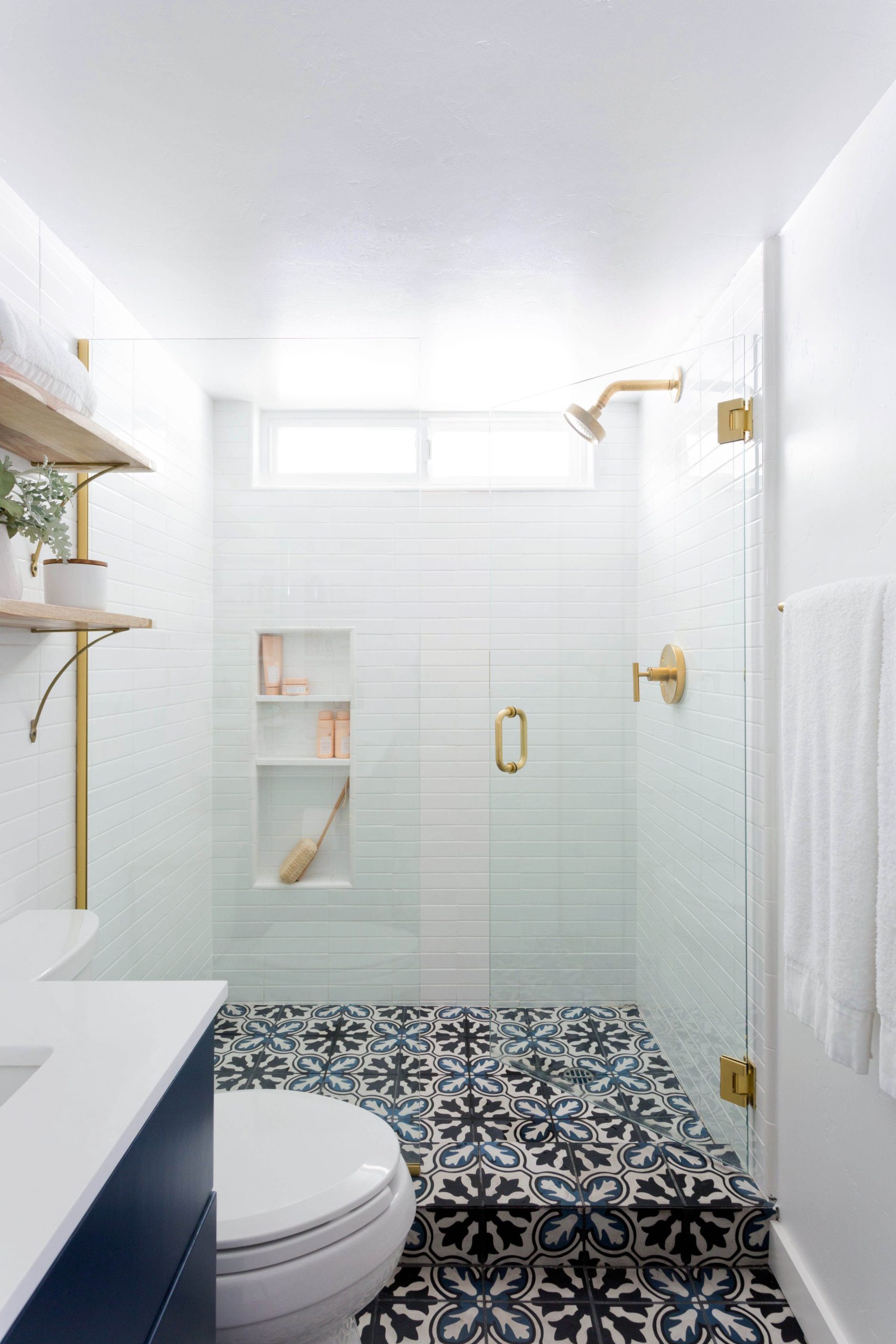Planning to shower in style? Try our shower floor ideas for a unique bathroom experience. Choose your storage from our exclusive shower niches designed for every bathroom need.
Are you dreaming of a shower that’s both functional and fabulous? This guide will help you transform your bathroom into a personal oasis with the perfect shower floor tiles. From materials and designs to the latest trends, we’ll cover everything you need to create a shower that feels like a spa and looks like a million bucks.
Shower Floor Tile Inspiration
Choosing the right shower floor tile is paramount to a successful bathroom renovation. It impacts not only the aesthetics but also safety, maintenance, and longevity. Let’s explore some inspiring ideas:
Tile Types
-
Pebble Tiles: These create a natural, spa-like atmosphere and offer excellent slip resistance. While they can be a bit more challenging to clean due to the crevices, the tranquil vibe may be worth the extra effort.
-
Mosaic Tiles: Incredibly versatile, mosaic tiles allow you to create intricate designs, add pops of color, or even form a picture on your shower floor. The design possibilities are endless.
-
Porcelain and Ceramic Tiles: Durable, budget-friendly, and available in a wide array of colors and designs, these are popular choices for a reason. They’re also incredibly easy to clean, making them perfect for busy households. Porcelain is generally considered more durable than ceramic, making it arguably the best overall choice for high-traffic areas.
-
Natural Stone Tiles: Materials like marble, slate, or travertine exude luxury and elegance. While they may require sealing to prevent stains and can be pricier, the upscale feel is undeniable. Some experts suggest annual sealing to maintain their pristine appearance.
-
Large Format Tiles: These oversized tiles create a sleek, modern look with fewer grout lines, simplifying cleaning. However, they can sometimes be slippery, so a textured finish is recommended for added safety.
Design Techniques
-
Mix and Match Tile Sizes: Combining different tile sizes adds visual interest and dynamism. Consider using smaller tiles as a border or inlay within larger tiles.
-
Play with Patterns: Herringbone, chevron, and windmill patterns introduce sophistication and movement. Ongoing research suggests certain patterns might even have a calming effect.
-
Define the Shower Area: Use contrasting tiles to visually separate your shower from the rest of the bathroom floor, creating a distinct, designated space.
-
Level-Access Shower: A level-access, or walk-in, shower offers both style and accessibility, eliminating the threshold for safer and more convenient entry.
As Jennifer Ebert, Digital Editor of Homes & Gardens, points out, playing with scale, especially with mosaic tiles, can significantly elevate your bathroom’s design. Think about how different sizes and shapes interact to create a captivating visual experience.
Sustainability and Maintenance
Sustainable choices like recycled glass tiles or locally sourced natural stone are gaining popularity. Don’t overlook grout color; it can either blend seamlessly or make your tile patterns pop. Regular cleaning is crucial, regardless of tile type, and specific cleaning solutions may be required for certain materials.
Choosing the Right Shower Floor Material
With so many options available, selecting the perfect shower floor tile can be overwhelming. Here’s a breakdown to help you make an informed decision:
Material Deep Dive
-
Porcelain: Highly durable, water-resistant, low porosity (prevents mildew and soap scum), and available in various styles, porcelain is often considered the best overall choice.
-
Ceramic: Similar to porcelain but slightly less durable, ceramic offers a budget-friendly alternative.
-
Glass: Stylish but potentially slippery, glass tiles require careful consideration. Textured or smaller mosaic glass tiles offer better grip.
-
Travertine: This natural stone adds elegance but requires sealing and more maintenance.
-
Pebble: Natural stone with excellent grip, pebble tiles can be trickier to clean due to the grout lines.
-
Marble: Luxurious natural stone that requires sealing and regular maintenance.
-
Vinyl: Budget-friendly and available in various styles, vinyl is generally less durable than tile.
-
Acrylic: Seamless and easy to clean, acrylic can be less durable than tile.
-
Wood: While it can create a natural look, wood requires specific sealant and meticulous maintenance to prevent water damage in a shower environment and is less common for this application.
Factors to Consider
- Budget: Tile prices vary significantly.
- Durability: Porcelain and ceramic are highly durable, while natural stone requires more care.
- Surface Texture: Textured, mosaic, or small-format tiles offer superior grip.
- Maintenance: Porcelain and ceramic are low-maintenance, while natural stone requires sealing and more frequent cleaning.
- Aesthetics: Choose a tile that complements your bathroom’s overall style.
Tips for Choosing
- Prioritize slip resistance for safety. “We highly suggest using either a mosaic porcelain or ceramic that has a lot of grout lines for traction or choosing a textured large format tile that will provide grip when you’re standing.” Smooth tiles, especially glass, can be extremely slippery when wet.
- Consider grout lines: smaller tiles create more grout lines, enhancing grip but requiring more cleaning.
- Choose a tile with low water absorption (porcelain excels in this area). “Porcelain tiles are an excellent choice for shower floor tiles due to their resistance to water, resilience, ease of maintenance, artistic diversity, and hygiene benefits.” Porcelain’s low water absorption rate makes it highly resistant to water damage, mold, and mildew growth.
- Research different tile sizes and patterns to achieve your desired aesthetic.
- Remember that research on tile materials is ongoing. Explore the latest innovations and expert advice.
| Material | Pros | Cons | Considerations |
|---|---|---|---|
| Porcelain | Durable, easy to clean, variety of designs | Can be cold, some can be slippery | Good for high traffic areas |
| Ceramic | Affordable, easy to clean, variety of designs | Less durable than porcelain | Good for low to moderate traffic areas |
| Stone (Marble) | Luxurious, durable | Expensive, can stain, can be slippery | Requires sealing, avoid with hard water |
| Stone (Travertine) | Luxurious, unique texture | Porous, requires regular cleaning | Requires sealing |
| Stone (Slate) | Durable, slip-resistant, rustic look | Can be expensive, can show scratches | Can be difficult to clean |
| Glass | Adds color and style, various colors/finishes | Can be slippery, more grout lines = more cleaning | Choose textured or small tiles for better grip |
| Wood-look Tile | Warm, natural look, water-resistant | Can be slippery, some require sealing | Choose textured for grip, ensure proper sealing |
Coordinating Shower and Floor Tile
One of the most common design dilemmas is whether shower tile and floor tile should match. There’s no single right answer, so let’s explore the different approaches:
Matching Tiles: Seamless Look
Using the same tile creates a unified, spacious feel, especially in smaller bathrooms. It also simplifies the design process.
Contrasting Tiles: A Splash of Personality
Mixing and matching tiles allows for creative expression and addresses practical concerns. You can prioritize slip-resistant tiles for the shower floor while choosing different tiles for the main bathroom floor based on aesthetics and ease of cleaning.
Finding the Right Balance
Even without perfectly matching tiles, you can achieve cohesion through coordinating colors, shapes, sizes, or textures. This creates a subtle connection without being overly matchy.
Factors to Consider
- Bathroom Size: Matching tiles maximize space in small bathrooms, while larger bathrooms offer more flexibility for contrast.
- Safety: Slip resistance is crucial for shower floors.
- Maintenance: Consider ease of cleaning for both shower and bathroom floors.
- Personal Style: Your tile choices should reflect your preferences.
The Perfect Shower Floor Color
Choosing the right shower floor color is crucial for aesthetics, maintenance, and even resale value. Here’s a guide to help you make the best decision:
Practical Considerations
- Hiding Imperfections: Darker shades conceal dirt and stains better than lighter colors.
- Maintenance: Matte finishes are more forgiving than glossy tiles, and textured tiles can minimize the appearance of imperfections.
- Size and Light: Light colors make small bathrooms feel larger, while darker colors create a cozy atmosphere in spacious bathrooms.
Style and Aesthetics
- Complementing Existing Decor: Choose a color that harmonizes with your bathroom’s overall color palette.
- Creating a Focal Point: A contrasting shower floor color can add visual interest.
- Timeless vs. Trendy: Classic colors like white, gray, and beige offer enduring appeal.
The Psychology of Color
- Blue/Green: Serene and calming.
- Warm Neutrals: Comforting and relaxing.
- Gray: Versatile and sophisticated.
- Bold Colors: Dramatic but require strategic use.
Material Considerations
- Porcelain/Ceramic: Offer a wide range of colors and styles.
- Natural Stone: Luxurious but require sealing and more care.
- Pebble Tile: Natural and slip-resistant.
Don’t Forget the Grout
Grout color plays a vital role. Contrasting grout can accentuate tile patterns, while matching grout creates a seamless look.
By considering these factors and exploring the plethora of options available, you can create a shower floor that is both beautiful and functional, transforming your bathroom into the sanctuary you’ve always dreamed of. Don’t hesitate to seek professional advice and experiment with different swatches to visualize your perfect shower floor.
- How to Remove Water Stains from Fabric: A Complete Guide - April 26, 2025
- How to Get Motor Oil Out of Clothes: Proven Methods & Expert Tips - April 26, 2025
- How to Get Deodorant Out of Black Shirts: Easy Stain Removal Guide - April 26, 2025










